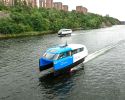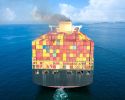New pre-study: Research and development must be coordinated

Suddenly it's for real. The world has decided that the human climate impact must be reduced and investments in the transition to sustainable shipping increased. That is why it is more important than ever that all research and development projects are structured and coordinated, say the researchers behind a new pre-study from Lighthouse.
Before researchers start a project, they always try to check what has been done before in the field and what’s going on. That’s usually not that easy, says Selma Brynolf, researcher at Chalmers.
“You often find what is published. But it is more difficult with projects that are underway or have not started. They are often not visible when you search because nothing has been published from them”, she says.
With the current situation, there is a risk that the wheel will be invented twice, ie that researchers in different places will do the same things. Selma Brynolf also believes that there is a risk that everyone moves in the same direction and that important research areas disappear in the noise of everything that happens. As an example she mentions the fact that not much research is done on how the existing fleet should be decarbonized.
Selma Brynolf is one of the researchers behind a new Lighthouse pre-study that examines how Research and development towards sustainable shipping should be structured and coordinated in Sweden. Another is Karl Jivén, a researcher at IVL:
“The feeling is a bit like that we have been preparing for 20 years and that things are really happening now. Now there is a hope that we will be able to solve this issue because so many are working on the problem”, he says.
Therefore, a better overview is needed. Due to the structure of the industry with many smaller stakeholders, the need is greater than in other industries. In shipping, even those who are familiar with it have difficulty with the overview.
“If we do not do something about this, the risk is not only that the changeover will be slower. There is also a risk that we will slip behind our neighbors. In both Norway and Denmark, for example, they are investing a lot”, says Karl Jivén.
So what should a national initiative for better coordination look like?
“Attempts have been made in such areas before, but have often failed because they have not received the update or the resources required to keep them alive. Therefore, it is important that the compilations are kept simple at first, perhaps with a requirement for the financiers to report when projects take place”, says Selma Brynolf.
The pre-study proposes that the information collected should be processed, made available and compiled regularly in such a way that efficient searches can be easily carried out by users. It must also be quality reviewed and kept up to date and relevant to users.
A national database would have many advantages; for example, the use of R&D funds would be streamlined and collaborations would be simplified and initiated more easily. Research funders would also find it easier to assess whether issues have been investigated and it would be easier to identify areas where there are knowledge gaps.
So finally, the big question: who is going to do the job? The pre-study suggests Lighthouse.
- It’s logical. As the Swedish and neutral collaboration platform for maritime research, Lighthouse have the overview. But regardless of the player, funds for this are needed, says Selma Brynolf.
The pre-study has been carried out in close collaboration with Wallenius Marine and Lighthouse.
Authors: Karl Jivén (IVL), Selma Brynolf (Chalmers), Erik Fridell (IVL) and Linda Styhre (IVL).
-
 NextWave – en podd som ska locka unga
NextWave – en podd som ska locka unga -
 Ny studie: Eldrivna pendelbåtar kan effektivisera Stockholms kollektivtrafik
Ny studie: Eldrivna pendelbåtar kan effektivisera Stockholms kollektivtrafik -
 Sjöfartens utsläpp ökar
Sjöfartens utsläpp ökar -
 Sociala relationer påverkar val av bränsle
Sociala relationer påverkar val av bränsle -
 Sjöfartens omställning kräver ”mjukare” påtryckningar
Sjöfartens omställning kräver ”mjukare” påtryckningar -
 Hon hade avtalad tid med Kapten ynkrygg
Hon hade avtalad tid med Kapten ynkrygg -
 Lighthouse omvärldsanalys 2025 – osäkerhet och tullar präglar sjöfarten
Lighthouse omvärldsanalys 2025 – osäkerhet och tullar präglar sjöfarten -
 Se seminariet Shipping in the Marine Environment
Se seminariet Shipping in the Marine Environment -
 Vad betyder egentligen de 90 procenten?
Vad betyder egentligen de 90 procenten? -
 Hålla där...
Hålla där...

